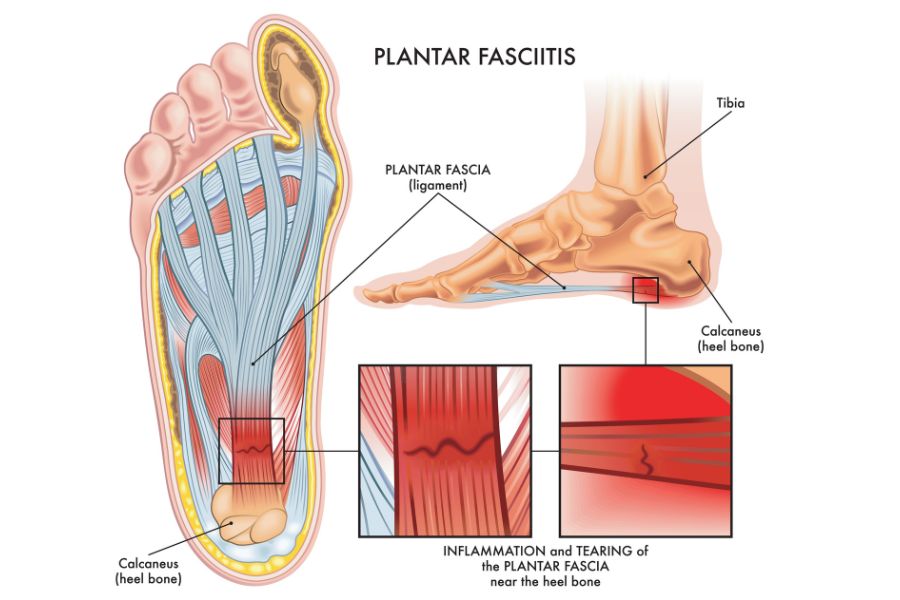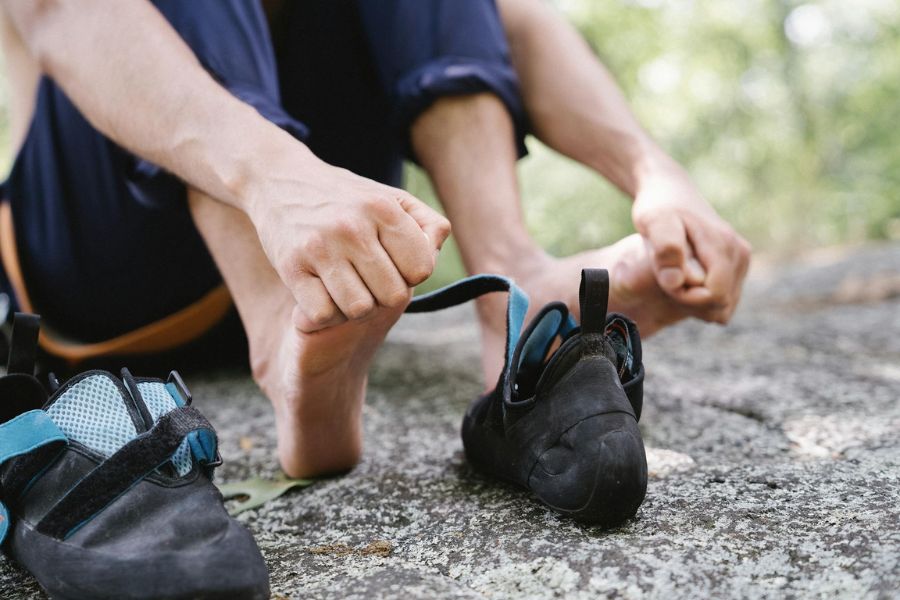Whether you’ve developed plantar fasciitis in the last week or you’ve suffered from it for years, you know the struggle to maintain a daily quality of life with this painful condition.
Plantar fasciitis is typically caused by factors like overuse, inadequate footwear, obesity, and abnormal foot mechanics. To fix it, treatments include rest, ice, stretching exercises, or wearing supportive footwear. In some cases, medical interventions like physical therapy or orthotics are necessary.
In this article, we’ll cover the causes of plantar fasciitis, how to fix it, and how to prevent future issues.
What is plantar fasciitis and what causes it?
Plantar fasciitis is a common condition causing foot pain in the heel and bottom of the foot. The plantar fascia is a thick band of tissue connecting the heel bone to the toes, supporting the arch of the foot. When this band becomes inflamed, it leads to plantar fasciitis.
Acute plantar fasciitis
Acute plantar fasciitis refers to the initial phase of the condition. Pain is usually sharp and located at the heel. It often occurs after intense physical activity or sudden changes in activity level. Immediate rest and ice application can help alleviate symptoms.
Chronic plantar fasciitis
Chronic plantar fasciitis develops if the condition is left untreated or if improper treatment is applied. The pain becomes more persistent and can interfere with daily activities. Treatment for chronic plantar fasciitis typically involves more prolonged and consistent care strategies.

Plantar fasciitis symptoms
The symptoms of plantar fasciitis can come on suddenly, after a single bout of exercise, or they can develop over time. Watch for:
- Sharp pain in the heel, especially after waking up or long periods of rest.
- Pain that worsens with activity and eases with rest.
- Stiffness and tenderness in the bottom of the foot.
- Pain after exercise (typically without any pain during the exercise)
- Pain when climbing stairs
Causes of plantar fasciitis
Plantar fasciitis can be triggered by several factors that strain the plantar fascia. Overuse, such as from running, walking long distances, or standing for extended periods, is a common cause, especially in individuals who suddenly increase their activity level.
Inadequate footwear lacking proper arch support and cushioning can also contribute to the condition, as can wearing high heels or shoes with thin soles.
An additional risk factor for plantar fasciitis is being overweight or obese. Maintaining a high body weight adds extra stress on the plantar fascia due to the increased weight it must support. Additionally, certain occupations that require prolonged standing or walking, such as teaching or factory work, can increase the risk.
Abnormal foot mechanics, like flat feet or high arches, can lead to improper weight distribution across the foot, further straining the plantar fascia. These factors combined can cause small tears and inflammation, leading to the characteristic pain of plantar fasciitis.
How to fix plantar fasciitis
Treatment for plantar fasciitis involves a combination of self-care strategies and professional medical interventions. For a detailed exercise program, see our article on exercises for plantar fasciitis relief here.
To relieve pain, try:
- Rest and Ice: Reduce activities that aggravate the condition and apply ice to the affected area.
- Stretching Exercises: Regular stretching of the calf muscles and plantar fascia can improve flexibility and reduce pain.
- Supportive Footwear: Wear shoes with good arch support and cushioning to reduce strain on the plantar fascia.
- Physical Therapy: A physical therapist can provide specialized exercises, mobilizations, and modalities to treat plantar fasciitis.
- Medications: Over-the-counter pain relievers like ibuprofen can help manage pain and inflammation.
- Orthotics: Custom or over-the-counter shoe inserts can provide additional support and relieve pressure on the plantar fascia.
- Medical Procedures: In severe cases, treatments such as corticosteroid injections or shock wave therapy may be recommended.

How to prevent plantar fasciitis
Preventing plantar fasciitis involves adopting practices that reduce stress on the plantar fascia and promote foot health:
- Wear Proper Footwear: Choose shoes with good arch support, cushioning, and a proper fit. Avoid wearing high heels or shoes with thin soles for prolonged periods.
- Maintain a Healthy Weight: Keeping your weight within a healthy range reduces the strain on your feet, decreasing the risk of plantar fasciitis.
- Gradually Increase Activity Levels: When starting a new exercise routine or increasing activity intensity, do so gradually to avoid overloading the plantar fascia.
- Incorporate Foot and Calf Stretches: Regular stretching of the calf muscles and the plantar fascia helps maintain flexibility and reduces tension. Simple exercises, such as calf stretches and toe curls, can be beneficial.
- Strengthen Foot Muscles: Strengthening the muscles in your feet through exercises like toe presses and marble pickups can provide better support to the plantar fascia.
- Use Orthotic Supports: Custom or over-the-counter orthotic inserts can provide additional arch support and cushioning, helping to distribute pressure more evenly across your feet.
- Avoid Walking Barefoot on Hard Surfaces: Walking barefoot on hard surfaces can strain the plantar fascia. Wear supportive shoes or slippers indoors if you have hard floors.
- Rest and Recover: Allow your feet time to rest and recover, especially after long periods of standing or intense physical activity. Alternate between activities to avoid repetitive strain.
- Massage and Ice: Regularly massaging your feet and applying ice can help keep the plantar fascia healthy and reduce inflammation.
Implementing these preventive measures can significantly reduce your risk of developing plantar fasciitis, ensuring that your feet remain healthy and pain-free.
FAQs about plantar fasciitis
The primary causes include overuse, improper footwear, obesity, prolonged standing, and abnormal foot mechanics.
The duration varies. With proper treatment, acute plantar fasciitis may resolve in a few weeks to months. Chronic cases might take longer, often requiring consistent and prolonged treatment strategies.
Yes, prevention strategies include: wearing supportive footwear, maintaining a healthy weight, incorporating foot and calf stretches into your routine, and gradually increasing activity levels to avoid overuse.
While swelling is not a primary symptom, it can occur in some cases due to inflammation. Rest and ice can help manage swelling.
Yes, the altered walking patterns and posture adjustments made to compensate for heel pain can lead to discomfort in the ankle, knee, calf, or leg. Addressing plantar fasciitis promptly can prevent these secondary issues.

















